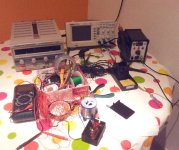smartbms
10 µW
Hi,
First at all, i'm a newbee, and you're reading my first post on this forum.
One year ago, i start develop a smart bms to finalize DIY ebike. Here a photo of :
Main characteristics :
- 8S cells frontend based on ISL94203 IC,
- powerfull low power STM32L103 MCU,
- 8 x 14 segments LCD display,
- 3 axis accelerometer to wakeup the pack,
- USB interface, for firmware upgrade and communication,
- small size 100x60mm, able to handle 30A, cell balancing, etc...
The hardware developping phase was a real pleasure, time to do some firmware : I started it with Chibios RTOS under a free of charge toolchain (Code Sourcery Lite / Eclipse CDT / GDB + STLINK probe) and with a lot of features in mind. I do made these items working :
- USB CDC serial support
- Command interpreter to read/write ISL94203 registers
- LCD driver (Chibios do not have it)
This was enough to debug my hardware and relauch a small batch of pcb (fully debugged ?)
I would continue on these software items :
- Low/high speed oscillator commutation if USB or not
- DFU bootloader on USB (to upgrade firmware in the field)
- Couloumb counting for fuel gauging (at 30Hz)
- Data logging (at very low rate, some statistics..)
- Cell impedance individual calculation during heavy loads
- DFU bootloader on USB (to upgrade firmware in the field...)
- etc
but to be frankly, firmware is not my cup of tea...
So, if somebody love STM32 MCU development under Linux with GCC rather soldering fine pitch SMT in his garage... let me know by PM.
First at all, i'm a newbee, and you're reading my first post on this forum.
One year ago, i start develop a smart bms to finalize DIY ebike. Here a photo of :
Main characteristics :
- 8S cells frontend based on ISL94203 IC,
- powerfull low power STM32L103 MCU,
- 8 x 14 segments LCD display,
- 3 axis accelerometer to wakeup the pack,
- USB interface, for firmware upgrade and communication,
- small size 100x60mm, able to handle 30A, cell balancing, etc...
The hardware developping phase was a real pleasure, time to do some firmware : I started it with Chibios RTOS under a free of charge toolchain (Code Sourcery Lite / Eclipse CDT / GDB + STLINK probe) and with a lot of features in mind. I do made these items working :
- USB CDC serial support
- Command interpreter to read/write ISL94203 registers
- LCD driver (Chibios do not have it)
This was enough to debug my hardware and relauch a small batch of pcb (fully debugged ?)
I would continue on these software items :
- Low/high speed oscillator commutation if USB or not
- DFU bootloader on USB (to upgrade firmware in the field)
- Couloumb counting for fuel gauging (at 30Hz)
- Data logging (at very low rate, some statistics..)
- Cell impedance individual calculation during heavy loads
- DFU bootloader on USB (to upgrade firmware in the field...)
- etc
but to be frankly, firmware is not my cup of tea...
So, if somebody love STM32 MCU development under Linux with GCC rather soldering fine pitch SMT in his garage... let me know by PM.



